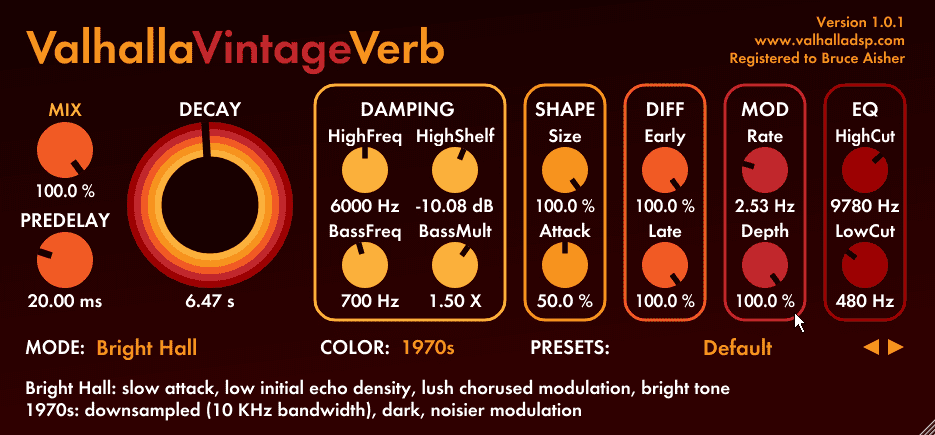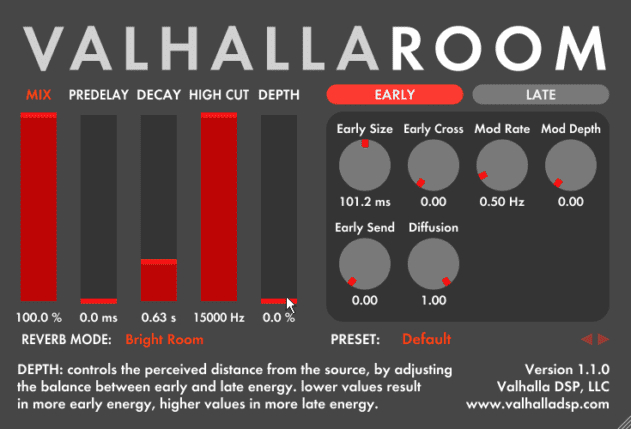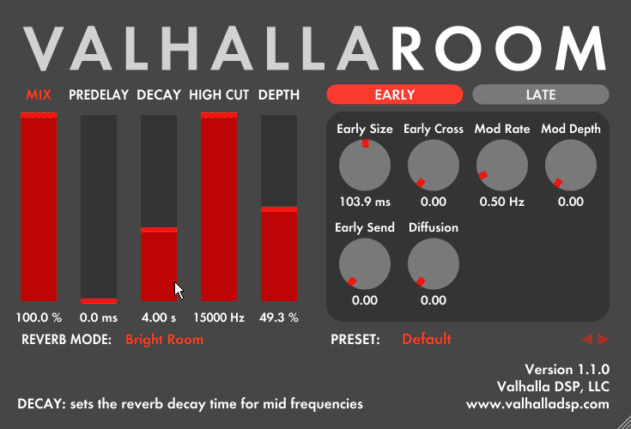Attack’s mix expert Bruce Aisher explains how to apply different types of reverb to each of the various elements of your track.
Alongside compression and EQ (which we explained in a walkthrough back in December), ambient treatments including reverb and delay are an essential element in creating a good mix. Reverb helps bring a mix to life by creating realism, depth and space. Of course, in electronic music, we’re not limited to recreating ‘realistic’ sounds – reverb is inextricably linked to sound design, and there are plenty of opportunities to get creative with unique sounds. Here we’re going to take a look at how a a dry and lifeless mix can be improved using a range of different reverb techniques. The principles here will explain how to apply reverb to any sound you use in your tracks.
In The Beginning
Here have the early stages of a house track in a very raw state. We’re at the point where we want to start thinking about mix ideas and how the rough idea should develop into a more complete track.
Although the rough mix is generally well balanced, it’s very dry.
A good place to start is with the percussive elements, and in particular those that might benefit from shorter ambient treatments. We’ll leave the kick alone for the time being as adding reverb to low frequency elements can quickly muddy the mix. Let’s look at the snare:
The sample is noticeably devoid of ambience, which makes it sound lifeless. Our brain is used to processing the echoes and reverberation that we hear in the real world, so when they’re missing it’s very noticeable.
Let’s start by setting up an effect send to add some early reflections:
In the Valhalla Room plugin we’ve created an emulation of what happens initially when sound hits hard surfaces in a room – a cluster of short delays. Using just these early reflections is a good way to avoid cluttering the space in a mix.
Adjusting the spacing and number of reflections can change the impression of the space quite dramatically:
Processing here is being taken care of by an algorithmic reverb plugin. These generally provide a far greater degree of adjustment than you’ll find possible with their more recent convolution-based cousins (which more accurately recreate the sonic signature of real spaces).
We can take this a stage further by adding the reverb tail to the mix – many algorithmic reverb plugins allow you to tweak these separately. This is what happens when all those room reflections combine and multiply.
This example is based around a ‘room’ program. These are typically a good place to start when trying to create a realistic studio ambience:
The next step is to decrease the reverb time so that you just get small reverberant ‘halo’ around the sound, and momentarily check this with the dry snare in order to avoid over-processing:



12.07 AM
Hey AM, nice article!
Just for clarification – are ‘early reflections’ another way of saying pre-delay, or is it a specific setting on some reverb plugins?
And thank you for introducing us to some nice looking reverb plugins. If you have any recommendations on some nice sounding free ones, I’d be muchly appreciated. 😉
Thanks for all the help,
James
12.22 AM
Hi James
The early reflections are the first cluster of echoes which reach your ears after a sound bounces back at you from the walls of a room. As those echoes pass your ears and continue echoing around the room, that’s the reverb tail. The pre-delay is the time it takes the early reflections to reach your ears after the initial sound.
In real-life terms, the pre-delay would be determined mainly by the size of the room. The sound of the early reflections would be determined by shape, surfaces, etc.
The best reverbs all depend on what you’re looking for. A lot of DAWs already have good ones. Logic’s Space Designer is particularly underrated. If you’ve got a little bit of money to spend and want something with real character, D16’s Toraverb is amazing for dance music and quite affordable. http://www.d16.pl/index.php?menu=228
01.11 AM
Ah, I see what you mean now.
So the size (i.e. drum room vs. church hall) determines the (number of) echoes and early reflections characteristics are dependent on what those echoes bounce off of, correct (i.e walls, chairs, windows, etc.)? And to make sure I have that correct, the only way to change the sound of early reflections would just be to change the actual ‘room’?
The quick response is appreciated! I’ll look into the D16 Toraverb as well. (If any readers have any suggestions for their ‘verbs of choice, I’d like to read)
James
01.19 AM
That all assumes you’re dealing with a reverb which tries to replicate the sound of real-life spaces. Some reverbs don’t make very much effort to sound ‘realistic’ (springs and earlier algorithmic reverbs, for example), whereas some are all about sounding as much like a real space as possible (convolution reverbs are the obvious choice here). It really all depends what reverb effect you’re using, what sound it tries to recreate and how much it allows you to customise that sound.
Ultimately, for electronic music it’s not usually worth getting hung up on the details of whether your reverb sounds realistic or not. It’s more important to consider whether it suits the track. Realism be damned!
We’ll put together a guide to the different types of reverb effect…
11.36 AM
Are there a feature somewhere in this page, to make it printer friendly?
11.48 AM
Hi mox. Our print stylesheet makes a few changes to the layout, including link targets in brackets, etc. If you’d prefer an exact replica of what you see on screen, you’re probably best off taking screenshots and then printing those. Hope that helps.
12.29 PM
Yeah, I already use to print yours articles with screenshots, but I was asking if there is a feature to print a whole article in one page, without the need of reprint of non-content things in each page.
Anyway, love attack mag! keep up the good work!
04.29 PM
The Attack Book… Watch this space…
Dave@Attack
03.04 AM
Another great article. Thanks a lot, are you going to write one about compressors?
04.04 PM
RVA – stay tuned!
10.18 AM
Great article. How about doing a series on ‘how to get that sound’ ? Where we could ask for particular sounds/artists?
10.57 AM
Definitely something we’re considering for the future…
02.04 PM
If one wants to place something further back in the mix, in order to create more front to back depth in their mix, what sort of reverb settings would be appropriate?
Longer decays and HF damping on the reverb? (Plus a possible high shelf cut?)
02.06 PM
Nice articles here. Detailed stuff covering several electronic music genres. You guys should make some stuff regarding vocals, I think it’s the only core part that you haven’t covered yet.
Keep it up mates.
09.09 AM
Great article shows alot of what not to do. Any tips on using reverb on basslines without muddying up the mix say how you would in big room house and some dubstep.
10.39 AM
James, the most important thing is to make sure the reverb is high-pass filtered. You can either filter on the send before the reverb or afterwards (they have subtly different effects) in order to cut out the lower frequencies and avoid them clogging up the bottom end of the mix.
From there you can experiment with pre-delay and decay times to find a sweet spot which gives just enough of a reverb tail on the bass notes.
In some cases it can also work well to use the unprocessed bass as a sidechain signal to control a compressor which ducks the reverb return every time the bass plays. That way it clears a space for itself, then allows the reverb to come back in and fill the gaps between notes.
It’s hard to get right, although if your mix and arrangement are sparse it can sometimes work well.
01.36 PM
Is Nonlin2 a free one? I’d be glad to know about any other non-linear reverbs.
05.45 PM
Very interesting tutorial! I realized how I always misused the reverb since now.
A short question: maybe I missed it in the article but is reverb used on a send channel or in insert? I suppose is in send but then how the amount to be send to the channel has to be set more or less?
Thanks!
09.28 PM
EOS, Valhalla Room and Valhalla Shimmer -all you need!
Great article btw, very helpful.
07.06 AM
Ok, I feel so stupid now. I jumped straight to the end listened to the last two audios, raw and reverbed ones, and for the life of me I cannot tell the difference. I do not have monitors, but I do have decent set of 2.1 speakers. What’s wrong with me? 😀
03.51 PM
The dry version sounds tighter and better to me.
10.15 AM
The dry version sounds like an old UK “JobFinder” soundtrack., The wet version sounds infinitely more engaging.
Top work. Did that book ever come out? (goes hunting)
04.12 PM
That bass with rev sounds dope tho. undesirable, really?
Also dry mix sounds tight, it could just do with the mid-top end percussion reverbs.
04.14 PM
you def need some 250+ ohm headphones fam. i recently bought and now i hear lots of things i have never listened in my life. For example look at that early reflections part. I first listened it with my monitors, didn’t hear that bouncing things until I listened again with my phones. (beyer dt 770 pro 250 ohm, go for it 10/10)